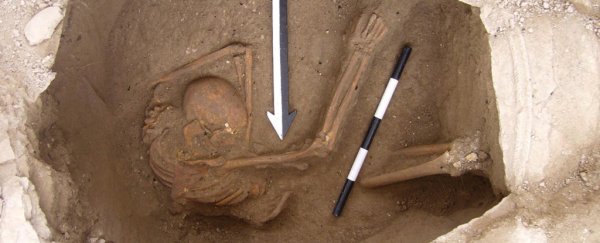A genetic analysis of 4,000 year old human remains identified as of Canaanite origin has revealed it's unlikely that the ancient population was wiped out, putting a new spin on an ancient story.
Ancient Hebrew texts describe how the Israelites reduced the cities and settlements of the Canaanite territory to rubble, but it seems the inhabitants themselves lived to pass on their genes to the modern day generations who still call Lebanon home.
Scientists from the Wellcome Trust Sanger Institute collaborated with an international team of researchers to sequence the genomes of five individuals dated to roughly 1,700 BCE from the Levant region.
The genes were then compared with genome sequences taken from 99 individuals of modern Lebanese ancestry, finding a significant match between the two populations.
If you go by the accounts in the Judeo-Christian scriptures, armies made up of Hebrews who fled Egypt attacked a number of cities and settlements in what is today broadly known as the Middle East, or Levant.
One of the more widely cited passages from the Bible's Book of Joshua describes the fall of the city of Jericho in what is today the Palestinian Territories, where the armies "utterly destroyed all that was in the city, both man and woman, young and old, and ox, and sheep, and ass, with the edge of the sword".
While the account isn't regarded as specifically historical by most scholars, it has inspired archaeologists to try to tease apart the myth from the facts when it comes to the cultures and bloodlines of one of the most conflict-prone regions on Earth.
The Bronze Age occupants of the lands were named Canaanites in Biblical accounts, a people who lived in an area bounded by Anatolia (or modern Turkey) to the north, Mesopotamia (roughly Iraq) to the east, and Egypt to the south.
According to the Greeks, the Iron Age cultures of the Near East who came after the Canaanites were called the Phoenicians, a conglomerate of city-states made up of a people who travelled widely through the Mediterranean and were responsible for developing one of the world's first alphabets.
While there are clear links in terms of religion and culture between the Phoenicians and Canaanites, details on the respective origins of these populations and how they might be related to today's generations have been rather scant.
For one thing, perhaps due to their use of papyrus rather than clay, the Canaanites left few written records to analyse. Most of what is known has been filtered through Egyptian and Greek accounts and archaeological interpretations.
The Greeks suggested the Canaanites came from further east, around the Persian Gulf, but modern researchers have found this isn't reflected by the evidence.
Instead it's believed their roots lie further back with Neolithic people who settled the region about 10,000 years ago.
This latest analysis of bones found during archaeological digs at the site of Sidon on the southern coast of modern Lebanon confirms this hypothesis.
They concluded that the Canaanites were descended from a mixture of people who had settled the region during the Neolithic revolution, with new blood added in migrations between around 6,600 and 3,500 years ago.
As for what happened to the people, they stuck around for a lot longer than the Bible would have us believe, with today's Lebanese populations sharing 90 percent of the genes with the old Canaanite bones.
The remaining 10 percent, it seems, came from even more migrants who settled the land between 1800 and 200 BCE, around the time of culture shift that saw the Bronze Age Canaanites give way to the Iron Age Phoenicians.
"For the first time we have genetic evidence for substantial continuity in the region, from the Bronze Age Canaanite population through to the present day. These results agree with the continuity seen by archaeologists," says Claude Doumet-Serhal, director of the excavation site in Sidon.
If it's been a hotly debated question for so long, it might seem odd that genetics is only now getting some solid answers. Unfortunately the climate in the Levant isn't exactly the best for old bones.
"It was a pleasant surprise to be able to extract and analyse DNA from 4,000-year-old human remains found in a hot environment, which is not known for preserving DNA well," says lead researcher Marc Haber from the Wellcome Trust Sanger Institute.
"We overcame this challenge by taking samples from the petrous bone in the skull, which is a very tough bone with a high density of ancient DNA. This method of extraction combined with the lowering costs of whole genome sequencing made this study possible."
While the genes might have lived on, there's still much work to be done to understand the cultures that have been lost to time.
This research is published in the American Journal of Human Genetics.
